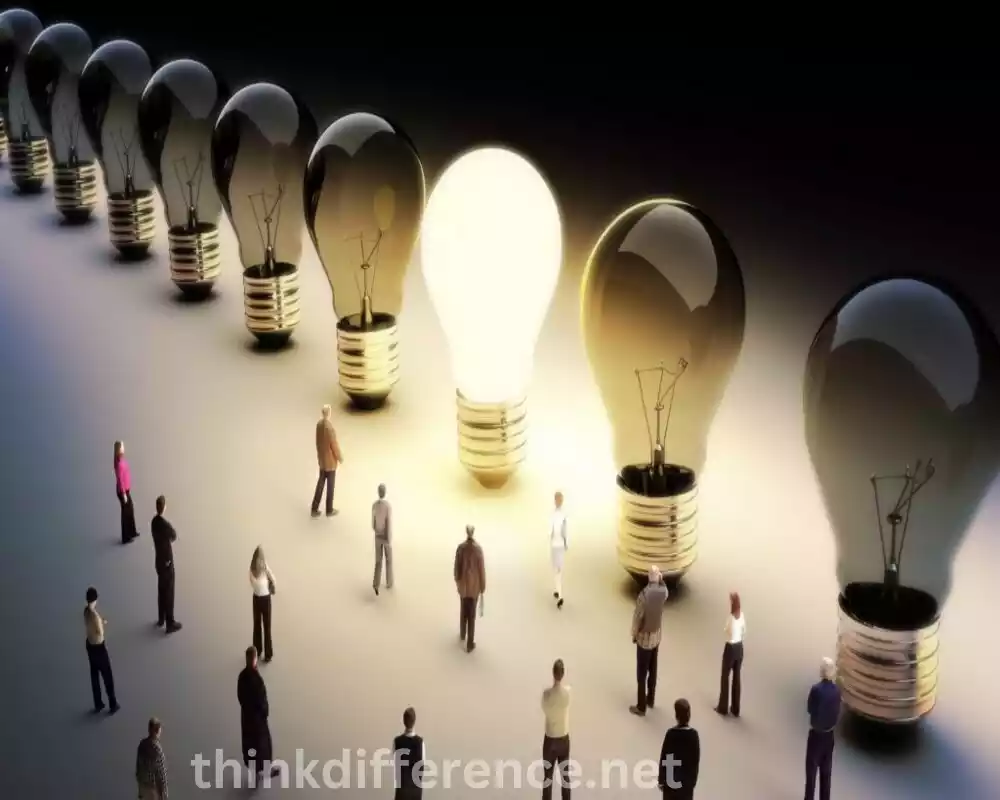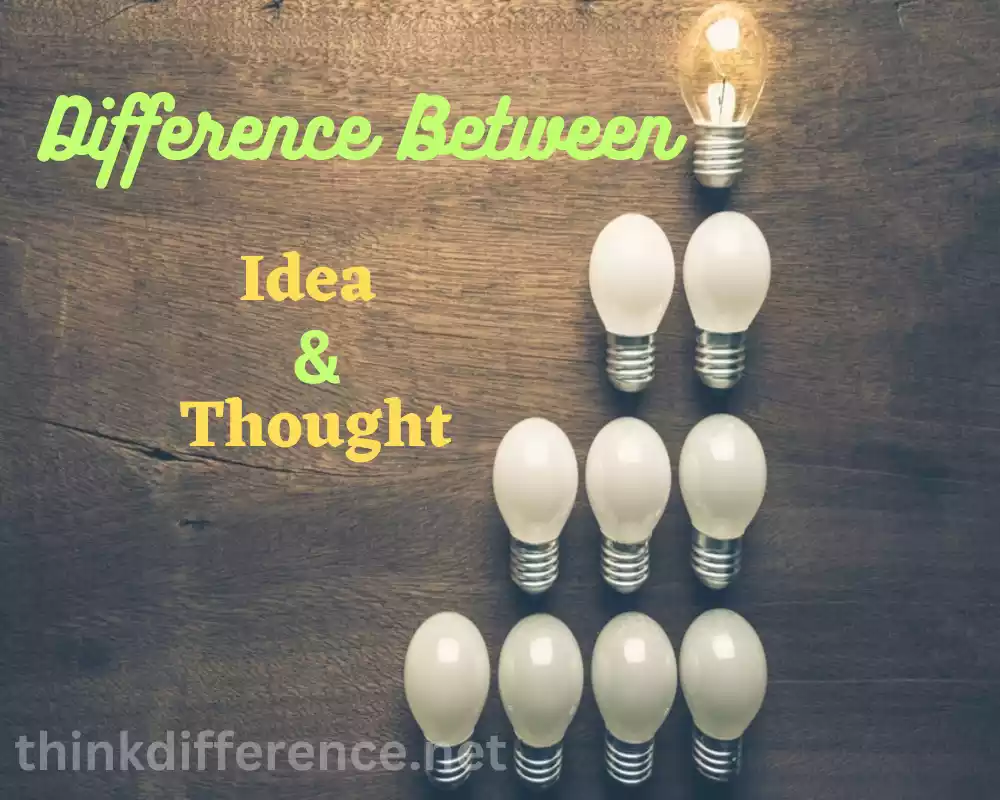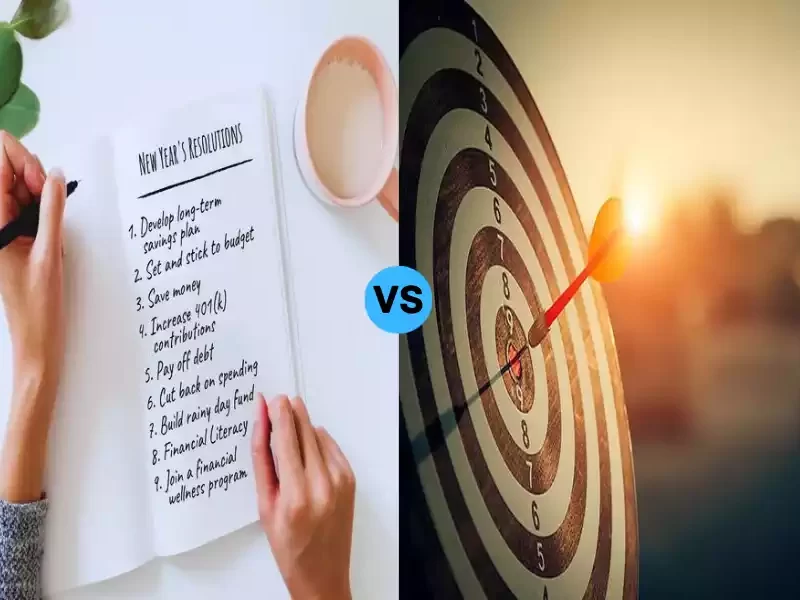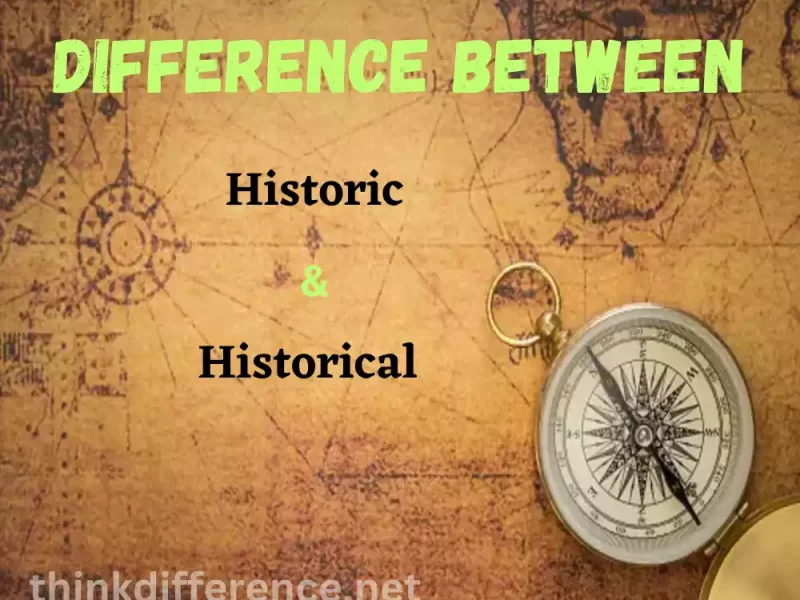Idea and Thought can be powerful drivers for progress and creativity in our world today. From revolutionary invention to stunning artwork or groundbreaking ideas – thoughts and ideas provide the seed that shape our lives and allow us to reach our full creative potential as human beings. Understanding their foundation allows us to harness their full power while realizing its full potential as individuals who embrace creative endeavor.
Importance of understanding the difference Between Idea and Thought
Understanding the difference between thoughts and ideas can be essential to our overall well being for various reasons:
- Clarity of Communication: Differentiating between ideas and thoughts helps in clear communication with others. By understanding that ideas are abstract concepts or proposals, while thoughts are personal mental processes, we can express ourselves more accurately and avoid confusion or misinterpretation.
- Creative Thinking and Innovation: Recognizing the distinction between ideas and thoughts allows us to foster creativity and innovation. Ideas are the seeds of new possibilities, while thoughts are the cognitive processes through which we analyze, evaluate, and refine those ideas. Understanding this difference helps us generate diverse ideas and engage in critical thinking to develop innovative solutions.
- Problem-Solving and Decision-Making: Understanding the difference between ideas and thoughts enhances our problem-solving abilities. Ideas provide potential solutions or approaches to a problem, while thoughts involve the cognitive processes of analyzing, evaluating and selecting the best course of action. By differentiating between the two, we can effectively evaluate ideas and make informed decisions.
- Self-Reflection and Self-Awareness: Understanding the difference between ideas and thoughts can lead to self-reflection and increase in self-awareness. Thoughts reflect our internal mental processes, including our beliefs, emotions and perceptions. By understanding our thoughts, we gain insights into our own thinking patterns, biases and values. This self-awareness allows us to introspect, grow and make conscious choices aligned with our values.
- Emotional Intelligence and Empathy: Differentiating between ideas and thoughts supports the development of emotional intelligence and empathy. Thoughts often involve emotions and subjective experiences, while ideas are more objective and conceptual. By understanding this distinction, we can recognize and empathize with others’ thoughts and emotions, promoting effective communication and building stronger relationships.
- Personal Development and Growth: Understanding the difference between ideas and thoughts contributes to personal development and growth. Reflecting on our thoughts, then analyzing them, can allow us to discover areas for improvement or challenge existing beliefs and broaden our perspectives. This self-exploration enables personal growth, fosters lifelong learning and enhances adaptability to new situations.
- Goal Setting and Achievement: Distinguishing between ideas and thoughts aids in goal setting and achievement. Ideas provide the initial inspiration or vision, while thoughts help us plan, strategize and take action towards achieving those goals. Understanding this distinction allows us to ensure our actions and thoughts align with our desired outcomes and increase the odds of achieving our goals.
Understanding the difference between thoughts and ideas is fundamental for effective communication, innovative problem-solving skills, self-reflection compassion personal growth as well as goal accomplishment. By recognizing their distinct characteristics and roles, we can harness their power and use them strategically in various aspects of our lives.
What is an Idea?
Concepts are conceptual representations, usually abstract ideas or abstractions that represent something existing or likely to exist, developed from human imagination and creative thought processes. Ideas range from simple thoughts to more intricate ones that arise as cognitive processes such as observation or analysis occur and when solving problems they emerge as new perspectives or opportunities.

Key characteristics of an idea include:
- Originality: Ideas are typically unique and not exact replicas of existing concepts. They involve novel combinations of existing knowledge, insights or perspectives.
- Creativity: Ideas often involve imaginative and inventive thinking. They can be innovative, unconventional and break away from established patterns or norms.
- Abstract nature: Ideas are conceptual and abstract in nature. They may not have a physical form or tangible manifestation until they are translated into action or expressed through various mediums.
- Potential for implementation: Ideas have the potential to be transformed into actions, products, services or solutions. They can drive change, spark innovation and influence the world around us.
Ideas can originate from various sources, including personal experiences, observations of the environment, exposure to new information or stimuli, conversations, research or deliberate brainstorming sessions. They can emerge spontaneously or through deliberate efforts to generate creative solutions or explore new possibilities.
Ideas serve an integral role in fields spanning business, science, art and technology as well as everyday problem-solving. Ideas provide the basis of progress, innovation and human growth while shaping technological advancements and our perception of life globally. It’s essential to acknowledge there can be many ideas with different impacts or practicality which need evaluating or applying in order to realize their full potential.
What is Thought?
Thought is an umbrella term used to refer to mental processes and activities which require thinking, perception, cognition and subjective experiences such as introspection. Thought includes inner dialogues, ideas beliefs and thoughts occurring within an individual. Be they conscious or subconscious they influence perceptions feelings behaviors as well as decision making processes.

Key characteristics of thoughts include:
- Mental process: Thoughts are cognitive processes that occur within the mind. They involve mental activities such as perception, attention, memory, analysis, synthesis and evaluation.
- Intangible and subjective: Thoughts are subjective experiences that are not directly observable or tangible. Mindsets and memories are individual. While thoughts can influence behavior and be communicated through language or other means, they are inherently personal and private.
- Involves cognition and perception: Thoughts are closely intertwined with cognitive processes. They involve the interpretation, analysis, and organization of sensory information, memories and knowledge. Thoughts are influenced by our beliefs, values, emotions and past experiences.
- Conscious or unconscious: Thoughts can occur at different levels of consciousness. Conscious thoughts are those that we are aware of and actively engage with. Unconscious thoughts refer to mental processes that operate below the level of conscious awareness, such as automatic thoughts or implicit biases.
- Thoughts take many shapes: logic and rational thinking can co-exist with intuitive and emotional processes like dreaming. Ideas might come through brainstorming sessions or imaginative ideation thinking sessions for creative problem-solving or reflection upon oneself and other issues or simply daydreaming. Thoughts may also be affected by external forces like social interactions social norms environmental influences as well as internal forces like memories emotions convictions etc.
Thoughts play an integral part in our self-awareness, reflection and understanding of the world around us. Through thinking aloud we gain greater awareness of ourselves as individuals while shaping perspectives, attitudes, behavior choices and decisions made throughout life. By studying and reflecting upon the thoughts that cross our minds we gain further understanding into cognitive processes such as processing speed or working memory capacity as well as challenging assumptions while adapting thinking patterns for enhanced personal development and growth.
Comparison table of Idea and Thought
Here’s a comparison table highlighting the key differences between ideas and thoughts:
| Aspect | Idea | Thought |
|---|---|---|
| Definition and Nature | A mental concept or formulation that represents something new, creative, or innovative. | Mental processes and activities of the mind, including perceptions, beliefs, opinions, reasoning, and internal dialogue. |
| Formation | Generated through cognitive processes like creativity, problem-solving, or inspiration. | Arise spontaneously or in response to stimuli, reflections, or mental associations. |
| Specificity and Focus | Specific, focused, and goal-oriented. | Can be broad, encompassing various topics, ideas, and perspectives. |
| Creativity and Innovation | Often associated with creativity and innovation, departing from existing patterns or conventions. | Can be creative, but not inherently focused on generating something new or innovative. |
| Influence and Action | Can lead to action and behavior change, driving change, inspiring projects, or problem-solving efforts. | Influence behavior, beliefs, perceptions, and attitudes, impacting decision-making and problem-solving. |
| Tangibility | Can be expressed, shared, and communicated to others, allowing for collaboration, feedback, and implementation. | Primarily internal and subjective experiences that may not always be easily communicable or translatable into external forms. |
Relationship between Idea and Thought
Thoughts and concepts are interlinked and have an ongoing effect on each other. While different concepts exist simultaneously, all share something in common that influences one another in various ways. Here are a few important features of their relationship:
- Generation of Ideas: Thoughts can be the origin of ideas. Through cognitive tasks such as thinking, analysis and reflection our minds could assist with creating innovative new concepts or ideas. Thoughts can serve as the building blocks or inspirations for generating creative and innovative ideas.
- Exploration and Refinement of Ideas: As soon as an idea takes form, thoughts play an essential part in exploring, refining, and expanding it. Through critical analysis and evaluation methods it’s possible to assess its viability, potential benefits and possible repercussions. Thoughts help us shape and develop the idea into a more concrete and actionable form.
- Implementation of Ideas: Ideas often require action to be realized and thoughts play a significant role in the implementation process. Thoughts help in planning, strategizing and translating ideas into practical steps or projects. They guide the execution of ideas by providing insights, problem-solving approaches and decision-making processes.
- Reflection on Ideas: After an idea is implemented or put into action, thoughts come into play again. We reflect on the outcomes, analyze the results and evaluate the success or failure of the idea. Thoughts allow us to learn from the experience, make adjustments and generate new ideas based on the lessons learned.
- Influence on Thoughts: Ideas can influence our thoughts and cognitive processes. Exposure to new ideas or perspectives can shape our thinking patterns, expand our horizons and challenge existing beliefs or assumptions. Ideas can stimulate critical thinking, inspire creativity and prompt us to reconsider or modify our thoughts and perspectives.
- Iterative Nature: The relationship between ideas and thoughts is iterative and dynamic. It involves an ongoing cycle of generation, exploration, refinement, implementation and reflection. Thoughts give rise to ideas, which in turn generate new thoughts, leading to a continuous cycle of growth, development and innovation.
Understanding the relationship between ideas and thoughts allows us to harness their potential effectively. By recognizing the iterative nature of this relationship, we can engage in creative thinking, critical analysis and intentional reflection, leading to the generation and realization of meaningful ideas. By being aware of how ideas shape our thoughts and vice versa, we can actively cultivate a mindset that embraces curiosity, open-mindedness and continuous learning.
The Power of Idea and Thought
Thoughts and ideas have an incredible capacity for change. Their influence extends far and wide. From shaping our lives and environments to effecting significant alterations. Here are a few aspects which showcase their immense impact:
- Innovation and Progress: Ideas drive innovation and expansion. They spark new possibilities, challenge existing paradigms, and drive advancements in various fields. From scientific discoveries to technological breakthroughs, societal reforms to artistic creations, ideas have the power to revolutionize industries, improve quality of life and push the boundaries of human knowledge.
- Problem-Solving and Solutions: Ideas and thoughts are instrumental in problem-solving. When we encounter challenges or obstacles, our thoughts generate ideas for potential solutions. By analyzing, evaluating and refining these ideas, we can develop effective strategies to overcome difficulties and find creative solutions to complex problems.
- Influence on Actions and Behaviors: Ideas and thoughts shape our actions, behaviors and decisions. Influences affect how we see ourselves – values, beliefs and attitudes are what drive our actions and choices. Whether it’s pursuing a new venture, advocating for a cause or making personal lifestyle changes, ideas and thoughts provide the motivation and direction for our actions.
- Social Impact and Change: Ideas and thoughts have the power to drive social impact and promote positive change. Revolutions of the past and political movements and social reforms often were driven by ideas which challenged established order while finding solutions for social ills. When shared and embraced by individuals and communities, ideas can mobilize collective action and inspire transformative change on a large scale.
- Personal Growth and Development: Thoughts play a crucial role in personal growth and development. Thoughts we think shape our self-perception and affect how we talk to ourselves about ourselves – which in turn influence emotional health. Positive and empowering thoughts can boost confidence, resilience and motivation, leading to personal growth, while negative or limiting thoughts can hinder progress and limit our potential. By encouraging positive thoughts and emphasizing self-reflection, we can foster an environment for personal development and satisfaction.
- Communication and Connection: Ideas and thoughts are vehicles for communication and connection. By sharing our feelings with one another, we create understanding, cooperation, sharing experiences and shared memories. They provide a means to express our perspectives, inspire dialogue and build relationships. Ideas and thoughts have the power to connect people, bridge differences and foster empathy and compassion.
- Personal Empowerment and Transformation: Ideas and thoughts have the potential to empower individuals and transform lives. One thought can ignite passion, change the course of a person’s life or inspire someone to pursue their goals. Positive affirmations increases self-confidence and resilience while inspiring positive transformational changes that help people overcome difficulties more efficiently while discovering strengths to lead more fulfilling lives.
The power of ideas and thoughts lies in their ability to shape our perspectives, drive innovation, influence actions, foster connection and bring about positive change. Integrating and making use of our ideas will enable us to tap the full potential of them, leading to positive effects for other individuals as well as having an effect influence on society as a whole.
Nurturing and Developing Idea and Thought
Nurturing and developing ideas and thoughts is a deliberate process that involves cultivation, exploration and refinement. Here are some strategies to effective Nurturing and developing ideas and thoughts is a deliberate process that involves cultivation, exploration and refinement. Here are some strategies to effectively nurture and develop ideas and thoughts:
- Cultivate Curiosity: Foster a curious mindset by actively seeking new experiences, knowledge and perspectives. Engage in lifelong learning, read widely, explore different fields and ask thought-provoking questions. Curiosity fuels the generation of new ideas and broadens the scope of our thoughts.
- Create an Inspiring Environment: Surround yourself with an environment that stimulates creativity and encourages deep thinking. Find spaces that inspire you, whether it’s a quiet corner, a natural setting or a vibrant workspace. Remove distractions, establish a routine and create a supportive atmosphere that encourages free thinking and exploration.
- Engage in Reflective Practices: Set aside dedicated time for reflection and introspection. Journaling, meditation or regular quiet contemplation can help you access your thoughts and gain deeper insights. Reflecting on your experiences, successes, and failures can spark new ideas and facilitate personal growth.
- Embrace Diverse Perspectives: Seek out diverse viewpoints and engage in meaningful conversations with people from different backgrounds and disciplines. Exposing yourself to different perspectives challenges your own assumptions and broadens your thinking. Embrace diversity of thought to foster innovative ideas and overcome biases.
- Embrace Failure and Iteration: Recognize that not all ideas and thoughts will be successful. Embrace failure as an opportunity for growth and learning. Allow yourself to iterate and refine your ideas through feedback, experimentation and continuous improvement. Failure can be a stepping stone to new insights and better ideas.
- Practice Active Idea Generation: Engage in deliberate idea generation techniques such as brainstorming, mind mapping or lateral thinking exercises. Set aside time for focused idea generation sessions where you generate a large quantity of ideas without judgment or evaluation. Encourage wild and unconventional ideas during this process.
- Seek Feedback and Collaboration: Share your ideas and thoughts with trusted individuals or mentors who can provide constructive feedback and different perspectives. Collaboration with others can help refine your ideas, uncover blind spots, and generate new insights. Actively seek out diverse collaborations that challenge and inspire your thinking.
- Embrace Continuous Learning: Keep learning and expanding your knowledge in areas relevant to your interests and ideas. Staying abreast of current developments, trends and research in your area of expertise is critical to staying ahead of competition and fulfilling client demands. Continuously seek out opportunities for growth and skill development to enhance your capacity to generate and develop ideas.
- Take Action and Experiment: Ideas and thoughts need to be translated into action for meaningful progress. Small steps should be taken in order to test out and implement your ideas in real life environments. Embrace experimentation, learn from the results and be open to adapting or pivoting based on feedback and outcomes.
- Embrace Solitude and Unplug: Allocate time for solitude and disconnect from constant distractions. Unplug from technology, social media and external influences to create space for deep thinking, introspection and idea incubation. Solitude allows for uninterrupted focus and fosters the development of deep thoughts and ideas.
By applying these strategies, you can nurture and develop your ideas and thoughts effectively. Remember that the process is iterative and requires patience, persistence and an openness to exploration and refinement. Embrace the journey of idea development as an opportunity for personal growth, innovation and the realization of your potential.
Harnessing Ideas and Idea and Thought
Harnessing ideas and thoughts for success involves channeling their power into action and achieving desired outcomes. Here are some strategies to effectively harness ideas and thoughts for success:

- Define Clear Goals: Clearly define your goals and objectives. An understanding of your desired goals provides clarity to your thoughts and plans for reaching them. Align your ideas and thoughts with your goals and use them as a driving force to propel you towards success.
- Prioritize and Focus: Prioritize your ideas and thoughts based on their relevance and potential impact. Focus your energy and efforts on those things which best reflect your objectives and offer the greatest promise for success. Avoid spreading your attention too thin by trying to pursue too many ideas simultaneously.
- Create an Action Plan: Create an action plan which details all of the steps necessary to turn your thoughts and ideas into tangible outcomes. Break down the plan into smaller, manageable tasks with clear timelines and milestones. This helps you stay organized, focused and accountable.
- Take Consistent Action: Take consistent action towards implementing your ideas and thoughts. Procrastination can hinder progress and dilute the power of your ideas. Set aside dedicated time for action and make it a habit to work consistently on your goals. Remember that small, consistent actions can lead to significant results over time.
- Embrace Adaptability: Remain open to adaptation and flexibility as you implement your ideas. Situations may change and new information might emerge. Be willing to adjust your approach, modify your ideas and pivot when necessary. Adaptability allows you to navigate challenges and optimize your path to success.
- Seek Knowledge and Expertise: Continuously seek knowledge and expertise related to your ideas and thoughts. Be on top of current trends in your field as well as best practices and innovations in that space. Seek advice and mentorship from professionals with expertise in your area – their insight can help develop ideas further while increasing opportunities for success.
- Cultivate Resilience: Success often requires resilience and perseverance. Understand that setbacks and failures are part of the journey. Learn from them, adapt and maintain a positive mindset. Cultivate resilience to overcome obstacles, stay motivated and continue pursuing your ideas and thoughts even in the face of challenges.
- Build a Supportive Network: Surround yourself with a supportive network of individuals who believe in your ideas and provide encouragement and constructive feedback. Join forces with people sharing similar goals or interests. Their support, insights and diverse perspectives can bolster your success.
- Reflect and Learn: Regularly reflect on your progress and learn from both successes and failures. Assess the efficacy of your thoughts and ideas and identify areas where improvements could be made before adapting your strategy accordingly. Embrace a growth mindset that values learning, iteration and continuous improvement.
- Celebrate Milestones and Successes: Celebrate your achievements and milestones along the way. Honor any progress, small it is. Celebrating successes fuels motivation, boosts confidence and reinforces the power of your ideas and thoughts.
By applying these methods, you can harness the full power of your ideas and thoughts towards success. Keep in mind that success requires continuous efforts, flexibility and positivity for best results. Stay committed, believe in your ideas and persevere through challenges to achieve the desired outcomes.
Conclusion
Ideas and Thoughts are the lifeblood of human progress and creativity. They have the potential to change lives, inspire generations, and shape the future. By embracing our creative nature, nurturing our ideas, and fearlessly pursuing our passions, we contribute to the beautiful tapestry of human ingenuity.



